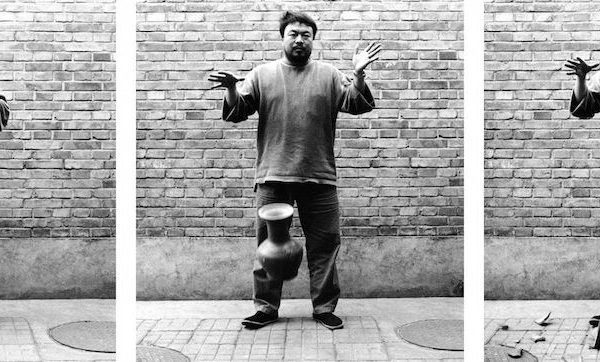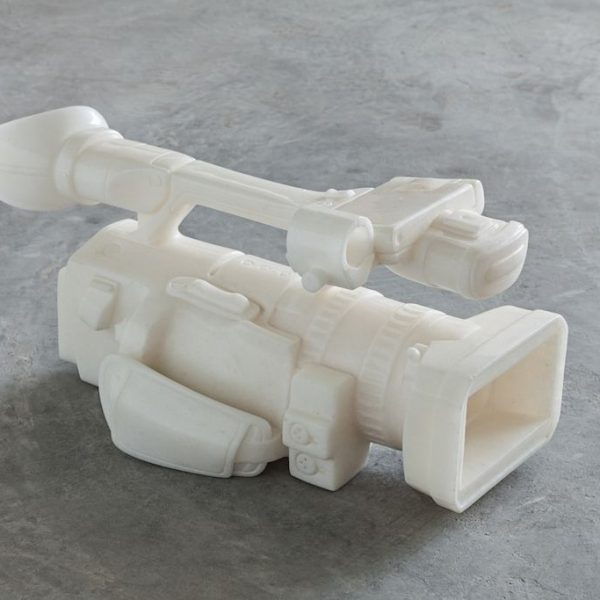
Main Galleries, Royal Academy of Art
19 September – 13 December 2015
- Ai Weiwei, Dropping a Han Dynasty Urn, 1995
3 black and white prints, each 148 x 121 cm
Courtesy of Ai Weiwei Studio
Image courtesy Ai Weiwei
(c) Ai Weiwei
- Ai Weiwei, Free Speech Puzzle, 2014
Hand painted porcelain in the Qing dynasty imperial style,
51 x 41 x 0.8 cm
Courtesy of Ai Weiwei Studio
Image courtesy Ai Weiwei
(c) Ai Weiwei
- Ai Weiwei, I.O.U. Wallpaper, 2011-13
Wallpaper, dimensions variable
Courtesy of Ai Weiwei Studio
Image courtesy Ai Weiwei
(c) Ai Weiwei
- Ai Weiwei, Coloured Vases, 2006
Neolithic vases (5000-3000 BC) with industrial paint, dimensions variable
Courtesy of Ai Weiwei Studio
Image courtesy Ai Weiwei
(c) Ai Weiwei
- Ai Weiwei, Remains, 2015
Porcelain, dimensions variable
Courtesy of Ai Weiwei Studio
Image courtesy Ai Weiwei
(c) Ai Weiwei
- Ai Weiwei, Straight, 2008-12
Steel reinforcing bars, 600 x 1200 cm
Lisson Gallery, London
Image courtesy Ai Weiwei
(c) Ai Weiwei
- Ai Weiwei, Table and Pillar, 2002
Wooden pillar and table from the Qing Dynasty (1644-1911), 460 x 90 x 90 cm
London, Tate. Purchased with funds provided by the Asia Pacific Acquisitions Committee, 2008
Image courtesy Ai Weiwei
(c) Ai Weiwei
- Portrait of Ai Weiwei (c) Harry Pearce, Pentagram 2015
- Ai Weiwei, Surveillance Camera, 2010
Marble, 39.2 x 39.8 x 19 cm
Courtesy of Ai Weiwei Studio
Image courtesy Ai Weiwei
(c) Ai Weiwei
- Ai Weiwei, Video Recorder, 2010
Marble, 43 x 19 x 19 cm
Courtesy of Ai Weiwei Studio
Image courtesy Ai Weiwei
(c) Ai Weiwei
London, 15 June 2015: In September 2015, the Royal Academy of Arts will present a landmark exhibition of the Honorary Royal Academician, Ai Weiwei. Although Ai is one of China’s leading contemporary artists, his work has not been seen extensively in Britain and the Royal Academy will present the first major institutional survey of his artistic output. The exhibition will include significant works from 1993 onwards, the date that marks Ai Weiwei’s return to China following more than a decade living in New York. Ai Weiwei will create new, site-specific installations and interventions throughout the Royal Academy’s spaces.
On his return to China in 1993, Ai began to work in a direction that was both embedded in Chinese culture and reflected the exposure he had had to Western art during his twelve year sojourn in the US. Citing Duchamp as ‘the most, if not the only, influential figure’ in his art practice, Ai continues to engage with creative tensions between complex art histories, conceiving works with multiple readings in the process. To this end he employs traditional materials and interventions with historic objects throughout his work from Neolithic vases (5000-3000 BCE) to Qing dynasty (1644-1911) architectural components and furniture. By creating new objects from old, Ai challenges conventions of value and authenticity in modern-day China. These artworks include Table and Pillar, 2002, from his Furniture
Ai works in a variety of different contexts, scales and media. He transforms materials to convey his ideas, whether in wood, porcelain, marble or jade, testing the skills of the craftsmen working to his brief in the process. Some pieces take months to create and pass through lengthy periods of experimentation, pushing the boundaries of the formal qualities of a material. Sculptures such as Surveillance Camera, 2010 and Video Camera, 2010, both masterpieces in craftsmanship, monumentalise the technology used to monitor, simultaneously rendering it useless and absurd. A new artwork, Remains, 2015, will also be included in the exhibition. Fabricated in porcelain, the work replicates in meticulous detail a group of bones that were recently excavated at a site of a labour camp that operated under Chairman Mao in the 1950s.
One of the key installations within the exhibition will be Straight, 2008-12, part of the body of work related to the Sichuan earthquake of 2008. Fabricated from ninety tonnes of bent and twisted rebar (the steel rods used in the construction of reinforced concrete buildings), collected by the artist and
straightened by hand, it is a sober monument to the victims of the earthquake. The subject of destruction, whether by demolition or as a consequence of natural disasters is one of a number of recurring themes and motifs that Ai returns to within his body of work.
Ai Weiwei said: “I’m honored to have the chance to exhibit at the Royal Academy of Arts. Tim Marlow and the rest of the exhibition team have a history of producing outstanding exhibitions. I’m very happy to be a part of it. This exhibition is my first major survey in London, a city I greatly admire. The selected artworks reflect my practice in recent years, and also include new works made specifically for this show.”
Tim Marlow, Artistic Director and co-curator of the exhibition, said: “Ai Weiwei is one of the most important artists in the world today but his work has not been seen anywhere near as much as it should have been in the UK. This exhibition will begin to redress that balance and give an extensive new audience the chance to experience a creative phenomenon that is at once radical, political, architectural, historical, poetic, materially inventive and transformative … even before they’ve walked through the Courtyard.”
Adrian Locke, co-curator of the exhibition said: “Working with Ai Weiwei has presented us with new challenges but his ability to comprehend space, even without having experienced it first hand, and the clarity of his vision for the use of that space in relation to his work has been revelatory.”
In 2011, Ai was detained for 81 days by the Chinese authorities. In an act of solidarity and support from his fellow artists and architects, Ai was elected an Honorary Member of the Royal Academy of Arts in May 2011. This exhibition will follow in the Royal Academy’s tradition of celebrating its Royal Academicians, continuing the strand of programming that has showcased some of the most significant living artists including Anish Kapoor, David Hockney and Anselm Kiefer.
Ai Weiwei has not been able to leave China since 2011 when his passport was confiscated. The exhibition has been developed in close collaboration with Ai, who has taken an architectural approach to the layout of the exhibition, within the Royal Academy’s spectacular Main Galleries, befitting the monumental character of many of his pieces. The artist has virtually navigated the spaces from his studio in Beijing, through video footage of the galleries and architectural plans. The curators have also made regular visits to his studio.
Edited by Qiwen Ke











